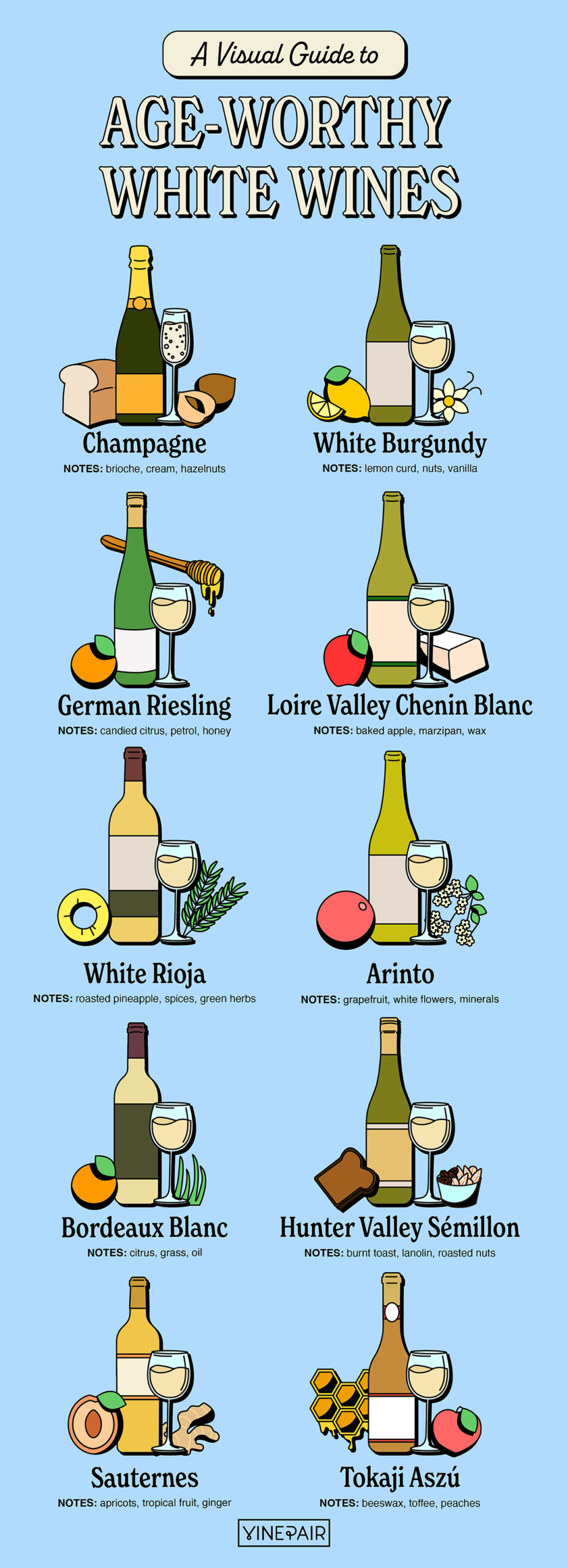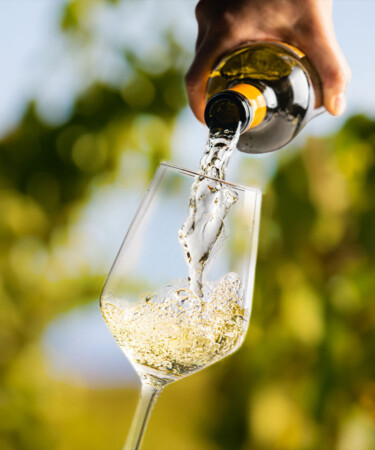The wine world is full of outdated, cringe-worthy advice that can often steer people away from great wines. One persistent example of this is the myth that only red wines can age. This idea is likely rooted in the misconception that red wines are inherently more luxurious, serious, and should be more expensive. Well, if you’ve subscribed to any of these concepts, it’s time to reevaluate your relationship with white wines.
That’s not to say that all wines are better when aged, but when they possess the right structure and characteristics, some time in bottle can unlock an entirely new and delicious experience. One of the reasons many might believe white wines can’t age is because tannins are an important component of what gives a wine lasting power. While white wines have minimal or no tannins, there are other factors in the wine that can contribute to its ageability — namely acidity and residual sugar. Tannins, acid, and sugar all slow down the oxidation process in a wine, which is what will make a wine fall flat eventually.
Having high acidity can also help keep the feeling of freshness in the wine over time. So, if you’re looking for a white wine to lay down for a few years, it is best to focus on high-acid varieties. Additionally, sweet wines or fortified wines with residual sugar can age incredibly well, with some examples remaining enjoyable for a hundred years or more.
While the 10 styles of wine below provide an overview of popular age-worthy white wines, there are so many more examples from around the world. While they aren’t listed below, we encourage you to experiment with aging others as well to see how they can evolve over time. High-quality Fiano di Avellino from Italy’s Campania region or high-acid Grüner Veltliner from Austria can develop some beautiful complexities over time if stored properly. So make room in your cellar for these age-worthy white wines — red wines aren’t the only bottles that get to have fun.
These are 10 examples of white wines that have some serious aging potential.

Vintage Champagne
While we’re fans of all Champagne, and non-vintage examples of this bubbly wine have great aging potential, too, the region only announces vintages in the best possible years, so buying a vintage Champagne will increase your odds of getting a high-quality wine that you can lay down for decades. Champagne is renowned for its blazing acidity, but sparkling wine also gets some help from the carbon dioxide that is trapped in the bottle. This element can also act as a preserving agent, giving these wines a long aging potential of 50 or more years. For many Champagne houses, they don’t even release certain vintage Champagne cuvées until they know they’re expressing the wine’s full potential — and then they can continue aging after that. For example, Champagne Billecart-Salmon just released the 2008 vintage of the Nicolas François 2008 prestige cuvée, which is still incredibly bright and youthful, and the 1998 vintage of the same wine is still vibrant and developing complexity.
White Burgundy
Chardonnay is a high-acid grape that can make stunning wines in many regions, but it’s most well known in France’s cool-climate region of Burgundy, where it makes wines with fresh acidity, great texture, and some added complexity from oak aging. These wines can drink well at 10 to 15 years of age, and the best examples can be held onto for much longer. Chardonnay grown in other cool regions that allow the grape to retain its acidity can age well, too. Hold on to a wine from the Sonoma Coast from a producer like Hirsch Vineyards for five or so years and give it a try.
German Riesling
Riesling is the queen of acidity. This laser-like wine can rip the enamel right off of your teeth, and we love it. German Riesling’s zippy acidity is often softened by some residual sugar, and the combination of the two can give Riesling an almost endless aging potential. Beyond the dry and off-dry examples, Riesling can make delicious late harvest sweet wines, and these can be essentially immortal. The variety’s signature structure allows examples from other regions like Alsace, Austria, Australia, and the Finger Lakes to age well, too.
Loire Valley Chenin Blanc
Chenin Blanc is another variety with killer acidity, and can also have a touch of sweetness depending on where and how it is made. For savory, complex versions of this grape, look to the wines of the Savennières appellation of the Loire Valley. Wines from this area are dry, have ripping acid, concentrated orchard fruit flavors, and develop a nutty, honeyed, almost marzipan-like flavor and texture with a few years of age. Alternatively, wines from the Loire Valley’s Vouvray region are made in a variety of residual sugar levels and can age extremely well, with the sweeter versions capable of cellaring for decades.
White Rioja
While Rioja is known for its age-worthy reds made from Tempranillo and Garnacha-dominant blends, there are also some incredible white wines coming out of this region that share this ability to age. Rioja’s white wines are also generally made with a blend of grapes, with Viura often playing a leading role. The Viura lends a vibrant acidity and intense flavors of honeydew melon, lime, tropical fruit, and herbs. Also similar to the reds, the white wines of this region can be aged in oak barrels, imparting some added notes of baking spices and vanilla. Producers in the region understand how the wines evolve over time, and often release the wines with some age on them. Renowned producer Conde de los Andes recently released a wine from its library collection — a White Rioja from 1983. This wine still has zingy acid, fresh pineapple and lemon flavors, with some nutty and herbaceous tertiary notes.
Arinto
Arinto is a grape native to Portugal that is commonly found in white blends throughout the country in regions like Alentejo, Vinho Verde, the Azores, and small regions around Lisbon like Bucelas. The variety is known for its extreme acidity, so it is often used to add the acidic structure as well as notes of lemon zest, grapefruit, and white flower to a blend. Arinto’s high acidity is what categorizes it as one of the most age-worthy white wines, giving it the ability to develop beautifully over five to 10 years, or longer.
Bordeaux Blanc
Bordeaux is another example of a place where the red wines usually get all of the aging cred. But this region’s white wines — and as you’ll see later, sweet wines — are just as notable and age-worthy. Bordeaux Blanc is typically a blend of Sauvignon Blanc and Sémillon, with small percentages of Muscadelle. Sauvignon Blanc contributes great acidity and minerality to the blends, while Sémillon offers concentrated orchard fruit notes and a round, oily texture to the wine. This combination of richness and acidity makes mind-boggling wines with great complexity that can easily age 10 years or more.
Hunter Valley Sémillon
Sémillon from Australia’s Hunter Valley is one of those rare examples where grape variety, location, and time come together to create inexplicable wine magic. While many age-worthy white wines can be perfectly enjoyable in their youth, these prized wines from the small region within New South Wales are generally unremarkable while young. Hunter Valley’s climate does not have any obvious benefits that would point to it making a great home for Sémillon. The region sits at a low latitude with small variations in day to night temperatures, and can have relatively wet and humid conditions. Honestly, it’s kind of a mystery how these wines develop such intense and captivating flavors with age. But after 20 years or more in the cellar, the bottles evolve into golden wines with nutty, honeyed notes, and an oily, rich mouthfeel.
Sauternes
We are returning to Bordeaux (and to Sémillon) with Sauternes, the sweet, dessert wines of the region. These wines are made with grapes that have been affected by botrytis, otherwise known as noble rot. This plant fungus develops in certain growing conditions, including the riverbanks of Bordeaux. Semillon typically plays a key role in these blends because the grape’s thin skins make it more susceptible to the rot. Botrytis causes the grapes to shrivel, which concentrates the sugars in the grapes and makes them perfect for sweet wine production. These wines develop notes of apricots, ginger, and beeswax, and can age for decades. And wines from great producers like the renowned Château d’Yquem are known to age a century.
Tokaji Aszú
Hungary’s crown jewel of wines is the sweet Tokaji Aszú, also made from grapes affected by botrytis. These golden, luscious wines were once the most sought-after by royalty like Hungarian noblemen, Catherine the Great, and King Louis XIV. The rich and expressive wines have such great sweetness and acidity, along with a delicious honeyed flavor, that they can often age 50 years or more. Tokaji Aszú can be made from a blend of six native grape varieties, including the most well known, Furmint. This variety has such high, zippy acidity that dry wines made from this grape are certainly age-worthy as well.
*Image sourced from petrrgoskov – stock.adobe.com
